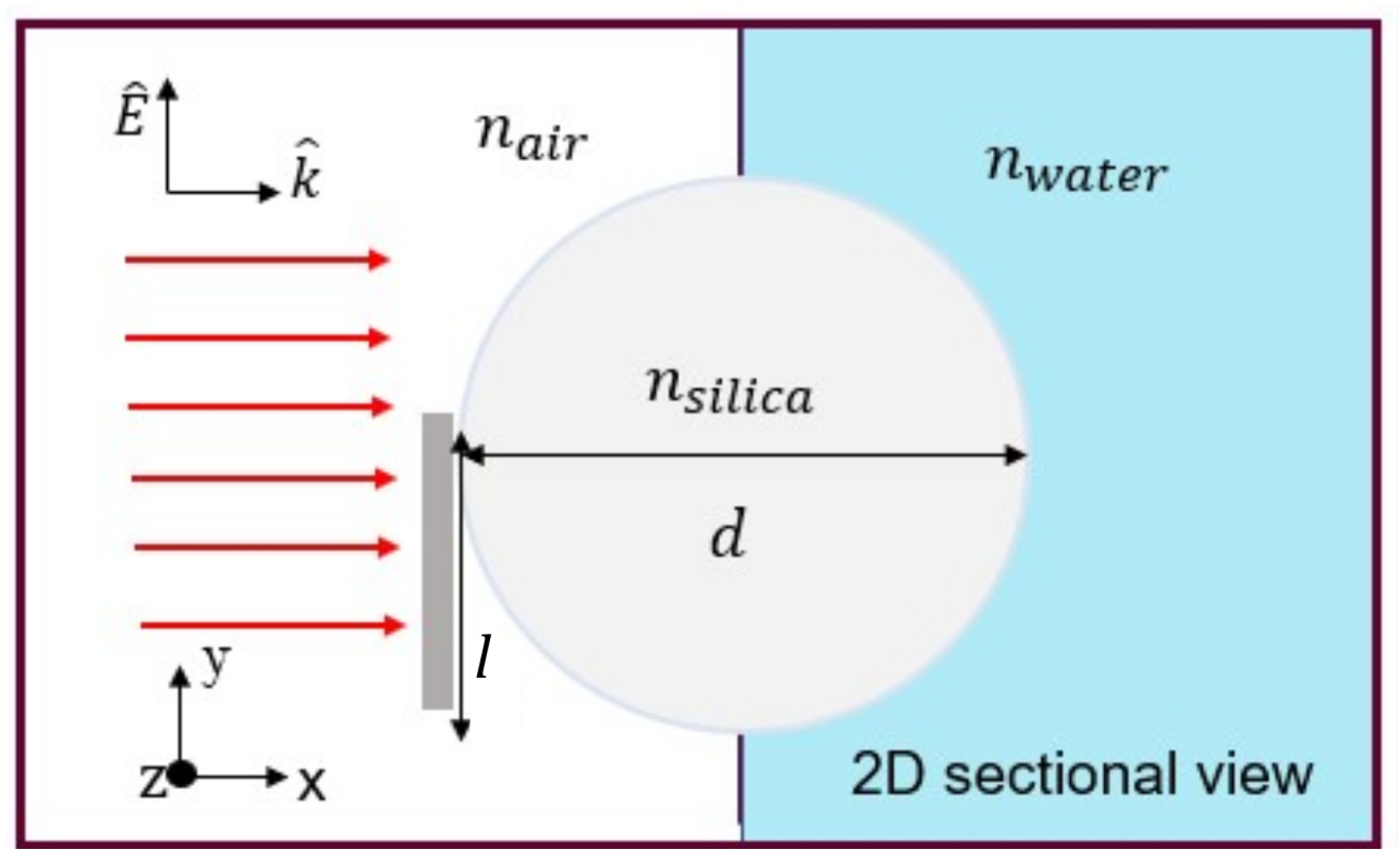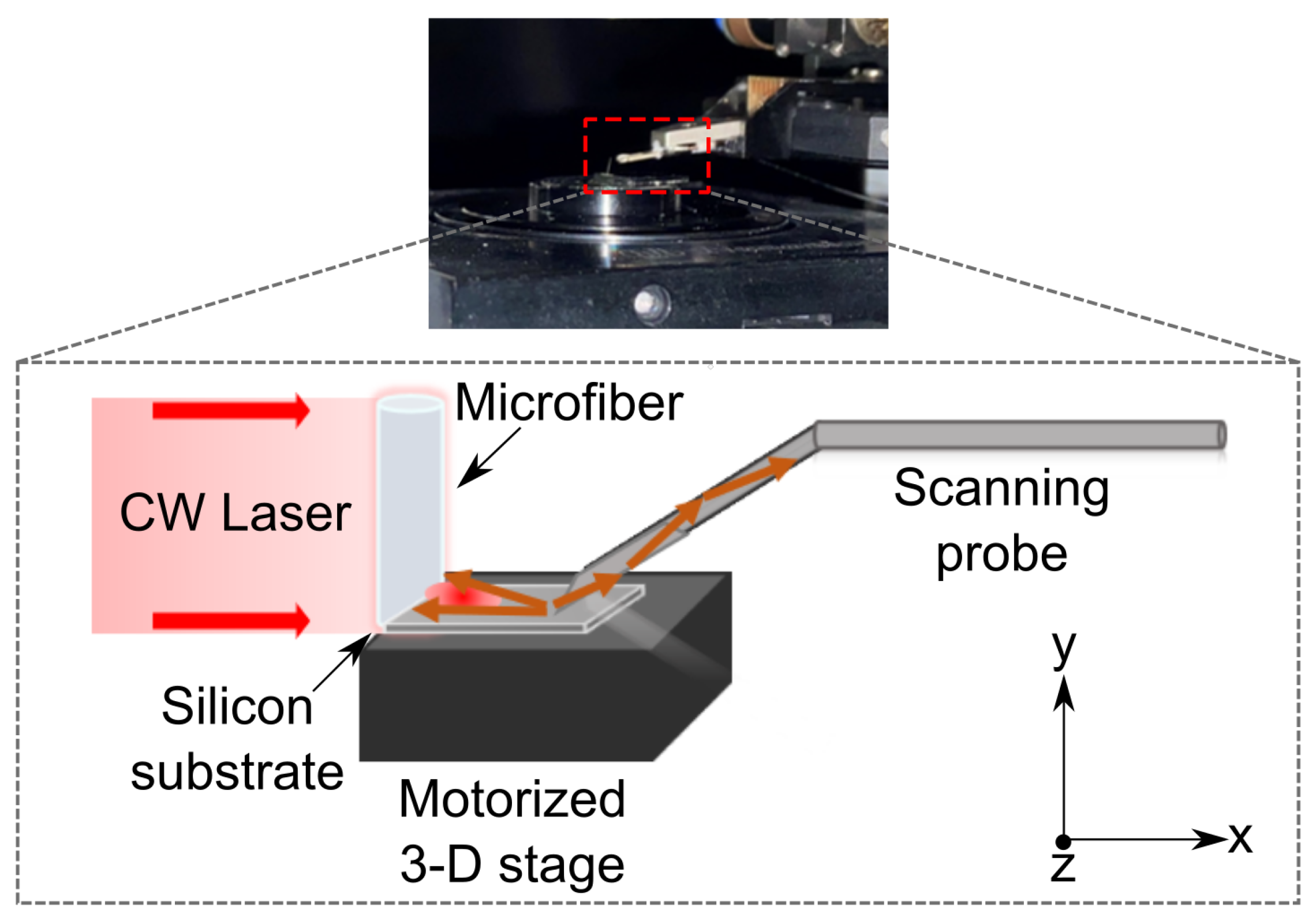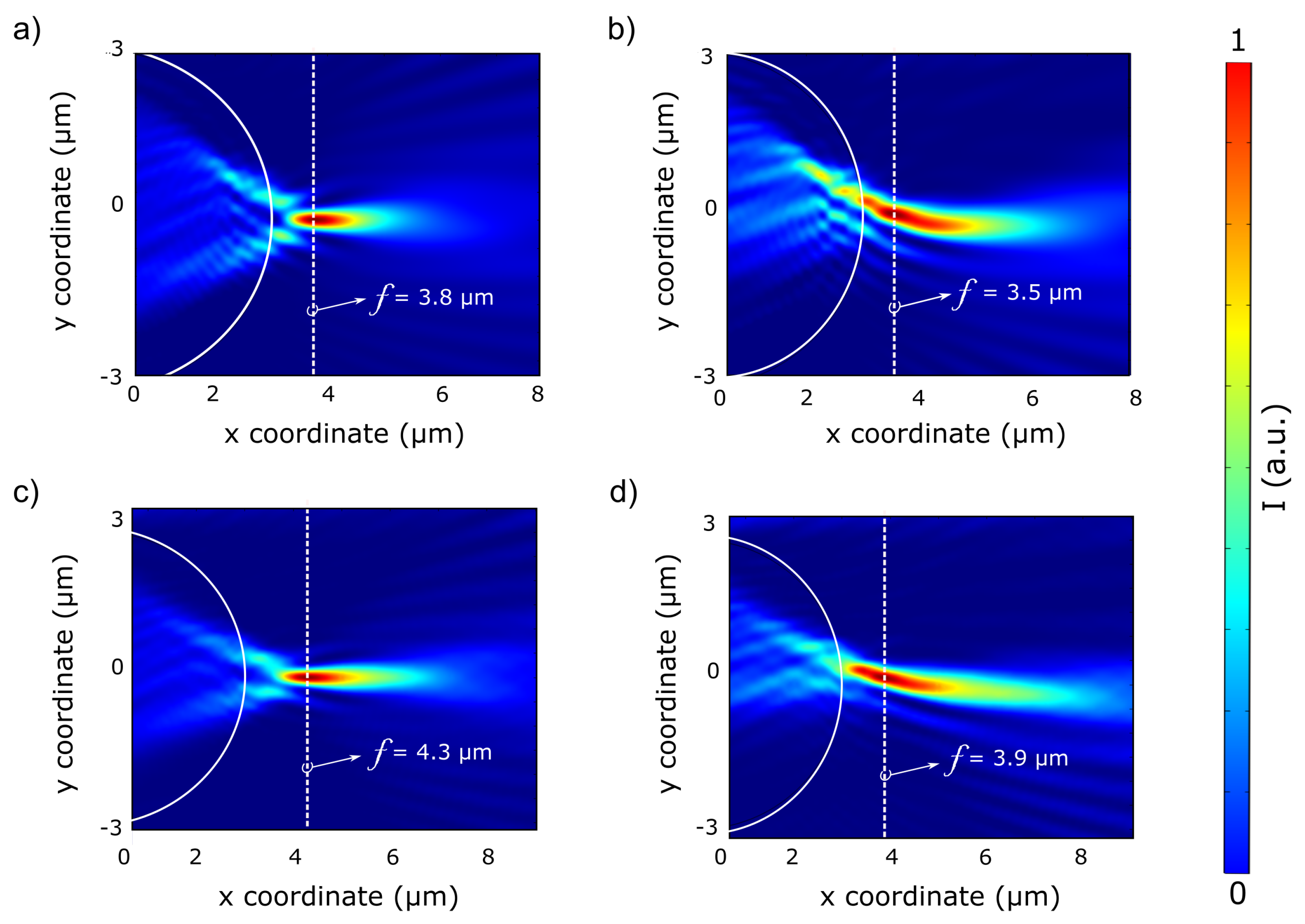Step-Index (Semi-Immersed) Model for Photonic Nanojet and Experimental Characterization via Near-Field Optical Microscopy with Microcylinder
Abstract
1. Introduction
2. Materials and Methods
2.1. Numerical Simulation
2.2. Fiber Preparation
2.3. Experimental Setup
3. Results
3.1. Numerical results
3.2. Experimental Characterization Results
4. Conclusions
Supplementary Materials
Author Contributions
Funding
Institutional Review Board Statement
Informed Consent Statement
Data Availability Statement
Conflicts of Interest
References
- Karabchevsky, A.; Katiyi, A.; Ang, A.S.; Hazan, A. On-chip nanophotonics and future challenges. Nanophotonics 2020, 9, 3733–3753. [Google Scholar] [CrossRef]
- Darafsheh, A. Photonic nanojets and their applications. J. Phys. Photonics 2021, 3, 022001. [Google Scholar] [CrossRef]
- Karabchevsky, A.; Elbaz, T.; Katiyi, A.; Prager, O.; Friedman, A. Super-Resolution Imaging and Optomechanical Manipulation Using Optical Nanojet for Nondestructive Single-Cell Research. Adv. Photonics Res. 2022, 3, 2100233. [Google Scholar] [CrossRef]
- Liu, C.Y.; Lin, F.C. Geometric effect on photonic nanojet generated by dielectric microcylinders with non-cylindrical cross-sections. Opt. Commun. 2016, 380, 287–296. [Google Scholar] [CrossRef]
- Chen, Z.; Taflove, A.; Backman, V. Photonic Nanojet Enhancement of Backscattering of Light by Nanoparticles: A Potential Novel Visible-Light Ultramicroscopy Technique. Opt. Express OE 2004, 12, 1214–1220. [Google Scholar] [CrossRef]
- Wang, Z.; Joseph, N.; Li, L.; Luk’Yanchuk, B. A review of optical near-fields in particle/tip-assisted laser nanofabrication. Proc. Inst. Mech. Eng. Part C J. Mech. Eng. Sci. 2010, 224, 1113–1127. [Google Scholar] [CrossRef]
- Spector, M.; Ang, A.S.; Minin, O.V.; Minin, I.V.; Karabchevsky, A. Temperature mediated ‘photonic hook’nanoparticle manipulator with pulsed illumination. Nanoscale Adv. 2020, 2, 2595–2601. [Google Scholar] [CrossRef]
- Yang, H.; Trouillon, R.; Huszka, G.; Gijs, M.A. Super-resolution imaging of a dielectric microsphere is governed by the waist of its photonic nanojet. Nano Lett. 2016, 16, 4862–4870. [Google Scholar] [CrossRef]
- Ang, A.S.; Karabchevsky, A.; Minin, I.V.; Minin, O.V.; Sukhov, S.V.; Shalin, A.S. ‘Photonic Hook’ based optomechanical nanoparticle manipulator. Sci. Rep. 2018, 8, 2029. [Google Scholar] [CrossRef]
- Ang, A.S.; Minin, I.V.; Minin, O.V.; Sukhov, S.V.; Shalin, A.; Karabchevsky, A. Low-contrast photonic hook manipulator for cellular differentiation. In Proceedings of the 9th Intternational Conference on Metamaterials, Photonic Crystals and Plasmonics, Marseille, France, 24 June–1 July 2018. [Google Scholar]
- Zhu, J.; Messinger, J.F.; Goddard, L.L.; Littlefield, A. Photonic Nanojets. Opt. Photonics News 2021, 32, 34–41. [Google Scholar]
- Gu, G.; Zhang, P.; Chen, S.; Zhang, Y.; Yang, H. Inflection point: A perspective on photonic nanojets. Photonics Res. 2021, 9, 1157–1171. [Google Scholar] [CrossRef]
- Minin, I.V.; Minin, O.V.; Liu, C.Y.; Wei, H.D.; Karabchevsky, A. Simulation and experimental observation of tunable photonic nanojet and photonic hook upon asymmetric illumination of a mesoscale cylinder with mask. arXiv 2020, arXiv:2004.05911. [Google Scholar]
- Dholakia, K.; Bruce, G.D. Optical hooks. Nat. Photonics 2019, 13, 229–230. [Google Scholar] [CrossRef]
- Gu, G.; Shao, L.; Song, J.; Qu, J.; Zheng, K.; Shen, X.; Peng, Z.; Hu, J.; Chen, X.; Chen, M.; et al. Photonic hooks from Janus microcylinders. Opt. Express 2019, 27, 37771–37780. [Google Scholar] [CrossRef] [PubMed]
- Neuman, K.C.; Block, S.M. Optical trapping. Rev. Sci. Instruments 2004, 75, 2787–2809. [Google Scholar] [CrossRef]
- Devilez, A.; Bonod, N.; Wenger, J.; Gérard, D.; Stout, B.; Rigneault, H.; Popov, E. Three-dimensional subwavelength confinement of light with dielectric microspheres. Opt. Express 2009, 17, 2089–2094. [Google Scholar] [CrossRef]
- Lecler, S.; Takakura, Y.; Meyrueis, P. Properties of a three-dimensional photonic jet. Opt. Lett. 2005, 30, 2641–2643. [Google Scholar] [CrossRef]
- Heifetz, A.; Simpson, J.J.; Kong, S.C.; Taflove, A.; Backman, V. Subdiffraction optical resolution of a gold nanosphere located within the nanojet of a Mie-resonant dielectric microsphere. Opt. Express 2007, 15, 17334–17342. [Google Scholar] [CrossRef]
- Luk’yanchuk, B.S.; Paniagua-Domínguez, R.; Minin, I.V.; Minin, O.V.; Wang, Z. Refractive Index Less than Two: Photonic Nanojets Yesterday, Today and Tomorrow [Invited]. Opt. Mater. Express 2017, 7, 1820. [Google Scholar] [CrossRef]
- Li, L.; Guo, W.; Yan, Y.; Lee, S.; Wang, T. Label-free super-resolution imaging of adenoviruses by submerged microsphere optical nanoscopy. Light. Sci. Appl. 2013, 2, e104. [Google Scholar] [CrossRef]
- Lu, Y.; Zhang, L.; Song, W.; Zheng, Y.; Luk’Yanchuk, B. Laser writing of a subwavelength structure on silicon (100) surfaces with particle-enhanced optical irradiation. J. Exp. Theor. Phys. Lett. 2000, 72, 457–459. [Google Scholar] [CrossRef]
- Li, Y.; Xin, H.; Liu, X.; Zhang, Y.; Lei, H.; Li, B. Trapping and detection of nanoparticles and cells using a parallel photonic nanojet array. ACS Nano 2016, 10, 5800–5808. [Google Scholar] [CrossRef] [PubMed]
- Zhang, X.A.; Chen, I.T.; Chang, C.H. Recent progress in near-field nanolithography using light interactions with colloidal particles: From nanospheres to three-dimensional nanostructures. Nanotechnology 2019, 30, 352002. [Google Scholar] [CrossRef] [PubMed]
- Li, Y.; Liu, X.; Li, B. Single-cell biomagnifier for optical nanoscopes and nanotweezers. Light. Sci. Appl. 2019, 8, 61. [Google Scholar] [CrossRef]
- Yang, S.; Taflove, A.; Backman, V. Experimental confirmation at visible light wavelengths of the backscattering enhancement phenomenon of the photonic nanojet. Opt. Express 2011, 19, 7084–7093. [Google Scholar] [CrossRef]
- Chen, Z.; Taflove, A.; Li, X.; Backman, V. Superenhanced backscattering of light by nanoparticles. Opt. Lett. 2006, 31, 196–198. [Google Scholar] [CrossRef]
- Yi, K.; Wang, H.; Lu, Y.; Yang, Z. Enhanced Raman scattering by self-assembled silica spherical microparticles. J. Appl. Phys. 2007, 101, 063528. [Google Scholar] [CrossRef]
- Liu, C.Y. Ultra-high transmission of photonic nanojet induced modes in chains of core–shell microcylinders. Phys. Lett. 2012, 376, 3261–3266. [Google Scholar] [CrossRef]
- Yang, H.; Cornaglia, M.; Gijs, M.A. Photonic nanojet array for fast detection of single nanoparticles in a flow. Nano Lett. 2015, 15, 1730–1735. [Google Scholar] [CrossRef]
- Gu, G.; Song, J.; Chen, M.; Peng, X.; Liang, H.; Qu, J. Single nanoparticle detection using a photonic nanojet. Nanoscale 2018, 10, 14182–14189. [Google Scholar] [CrossRef]
- Ristori, A.; Hamilton, T.; Toliopoulos, D.; Felici, M.; Pettinari, G.; Sanguinetti, S.; Gurioli, M.; Mohseni, H.; Biccari, F. Photonic Jet Writing of Quantum Dots Self-Aligned to Dielectric Microspheres. Adv. Quantum Technol. 2021, 4, 2100045. [Google Scholar] [CrossRef]
- Wang, S.; Ding, T. Plasmon-assisted nanojet lithography. Nanoscale 2019, 11, 9593–9597. [Google Scholar] [CrossRef] [PubMed]
- Liu, C.Y. Flexible photonic nanojet formed by cylindrical graded-index lens. Crystals 2019, 9, 198. [Google Scholar] [CrossRef]
- Minin, I.V.; Minin, O.V. Diffractive Optics and Nanophotonics: Resolution Below the Diffraction Limit; Springer: Berlin/Heidelberg, Germany, 2016. [Google Scholar]
- Murphy, D.B. Fundamentals of Light Microscopy and Electronic Imaging; John Wiley & Sons: Hoboken, NJ, USA, 2002. [Google Scholar]
- Li, Y.C.; Xin, H.B.; Lei, H.X.; Liu, L.L.; Li, Y.Z.; Zhang, Y.; Li, B.J. Manipulation and detection of single nanoparticles and biomolecules by a photonic nanojet. Light. Sci. Appl. 2016, 5, e16176. [Google Scholar] [CrossRef] [PubMed]
- Yang, H.; Gijs, M.A. Optical microscopy using a glass microsphere for metrology of sub-wavelength nanostructures. Microelectron. Eng. 2015, 143, 86–90. [Google Scholar] [CrossRef]
- Bazylewski, P.; Ezugwu, S.; Fanchini, G. A review of three-dimensional scanning near-field optical microscopy (3D-SNOM) and its applications in nanoscale light management. Appl. Sci. 2017, 7, 973. [Google Scholar] [CrossRef]
- Kirstein, S. Scanning near-field optical microscopy. Curr. Opin. Colloid Interface Sci. 1999, 4, 256–264. [Google Scholar] [CrossRef]
- Zayats, A.V.; Richards, D. Nano-Optics and Near-Field Optical Microscopy; Artech House: Norwood, MA, USA, 2009. [Google Scholar]
- Lecler, S.; Perrin, S.; Montgomery, P. Physics of 3D Microsphere Assisted Microscopy. In Proceedings of the 2019 21st International Conference on Transparent Optical Networks (ICTON), Angers, France, 9–13 July 2019; pp. 1–4. [Google Scholar]
- Carpes, W.P., Jr.; Pichon, L.; Razek, A. A 3D finite element method for the modelling of bounded and unbounded electromagnetic problems in the time domain. Int. J. Numer. Model. Electron. Netw. Devices Fields 2000, 13, 527–540. [Google Scholar] [CrossRef]
- McPeak, K.M.; Jayanti, S.V.; Kress, S.J.; Meyer, S.; Iotti, S.; Rossinelli, A.; Norris, D.J. Plasmonic films can easily be better: Rules and recipes. ACS Photonics 2015, 2, 326–333. [Google Scholar] [CrossRef]
- Malitson, I.H. Interspecimen comparison of the refractive index of fused silica. Josa 1965, 55, 1205–1209. [Google Scholar] [CrossRef]
- Kabakova, I.V.; De Hoogh, A.; Van Der Wel, R.E.; Wulf, M.; Le Feber, B.; Kuipers, L. Imaging of electric and magnetic fields near plasmonic nanowires. Sci. Rep. 2016, 6, 22665. [Google Scholar] [CrossRef] [PubMed]
- Wiecha, M.M.; Al-Daffaie, S.; Bogdanov, A.; Thomson, M.D.; Yilmazoglu, O.; Kppers, F.; Soltani, A.; Roskos, H.G. Direct near-field observation of surface plasmon polaritons on silver nanowires. ACS Omega 2019, 4, 21962–21966. [Google Scholar] [CrossRef]
- Kawata, S.; Inouye, Y.; Verma, P. Plasmonics for near-field nano-imaging and superlensing. Nat. Photonics 2009, 3, 388–394. [Google Scholar] [CrossRef]
- Le Feber, B.; Rotenberg, N.; Beggs, D.M.; Kuipers, L. Simultaneous measurement of nanoscale electric and magnetic optical fields. Nat. Photonics 2014, 8, 43–46. [Google Scholar] [CrossRef]
- Kuznetsov, A.I.; Miroshnichenko, A.E.; Brongersma, M.L.; Kivshar, Y.S.; Luk’yanchuk, B. Optically resonant dielectric nanostructures. Science 2016, 354, aag2472. [Google Scholar] [CrossRef]
- Lecler, S.; Perrin, S.; Leong-Hoi, A.; Montgomery, P. Photonic jet lens. Sci. Rep. 2019, 9, 4725. [Google Scholar] [CrossRef]
- Karabchevsky, A.; Katiyi, A.; Bin Abdul Khudus, M.I.M.; Kavokin, A.V. Tuning the near-infrared absorption of aromatic amines on tapered fibers sculptured with gold nanoparticles. ACS Photonics. 2018, 5, 2200–2207. [Google Scholar] [CrossRef]
- Zhou, S. Effects of light polarization in photonic nanojet. Opt. Quantum Electron. 2019, 51, 112. [Google Scholar] [CrossRef]
- Geinz, Y.; Zemlyanov, A.; Panina, E. Photonic Jet as a Technique for Optical Field Localization Near the Surface of Spherical Dielectric Microparticles. Russ. Phys. J. 2015, 57, 1165–1171. [Google Scholar] [CrossRef]
- Guo, H.; Han, Y.; Weng, X.; Zhao, Y.; Sui, G.; Wang, Y.; Zhuang, S. Near-field focusing of the dielectric microsphere with wavelength scale radius. Opt. Express 2013, 21, 2434–2443. [Google Scholar] [CrossRef]
- Cui, X.; Erni, D.; Hafner, C. Optical Forces on Metallic Nanoparticles Induced by a Photonic Nanojet. Opt. Express OE 2008, 16, 13560–13568. [Google Scholar] [CrossRef] [PubMed]
- Taylor, R.S.; Hnatovsky, C. Trapping and mixing of particles in water using a microbubble attached to an NSOM fiber probe. Opt. Express 2004, 12, 916–928. [Google Scholar] [CrossRef] [PubMed]







| Medium | Screen Height [m] | Focal Length [m] | Tilt Angle | Maximum Intensity [W/m] | FWHM | Longitudinal Size [nm] |
|---|---|---|---|---|---|---|
| Air | 3.8 | 0.48 | 5.3 | |||
| 3.5 | 0.54 | 6.0 | ||||
| Air-water | 4.3 | 0.47 | 7.0 | |||
| 3.9 | 0.62 | 9.0 |
| Method | Focal Length (m) | Intensity | FWHM | Longitudinal Size (m) |
|---|---|---|---|---|
| Simulation | 6.5 | 25.6 | 0.584 | 2.5 |
| Experiment | 6.7 | 14.3 | 0.578 | 2.4 |
Disclaimer/Publisher’s Note: The statements, opinions and data contained in all publications are solely those of the individual author(s) and contributor(s) and not of MDPI and/or the editor(s). MDPI and/or the editor(s) disclaim responsibility for any injury to people or property resulting from any ideas, methods, instructions or products referred to in the content. |
© 2023 by the authors. Licensee MDPI, Basel, Switzerland. This article is an open access article distributed under the terms and conditions of the Creative Commons Attribution (CC BY) license (https://creativecommons.org/licenses/by/4.0/).
Share and Cite
Elbaz, T.; Chauhan, A.; Halstuch, A.; Shalev, G.; Karabchevsky, A. Step-Index (Semi-Immersed) Model for Photonic Nanojet and Experimental Characterization via Near-Field Optical Microscopy with Microcylinder. Nanomaterials 2023, 13, 1033. https://doi.org/10.3390/nano13061033
Elbaz T, Chauhan A, Halstuch A, Shalev G, Karabchevsky A. Step-Index (Semi-Immersed) Model for Photonic Nanojet and Experimental Characterization via Near-Field Optical Microscopy with Microcylinder. Nanomaterials. 2023; 13(6):1033. https://doi.org/10.3390/nano13061033
Chicago/Turabian StyleElbaz, Tal, Ankit Chauhan, Aviran Halstuch, Gil Shalev, and Alina Karabchevsky. 2023. "Step-Index (Semi-Immersed) Model for Photonic Nanojet and Experimental Characterization via Near-Field Optical Microscopy with Microcylinder" Nanomaterials 13, no. 6: 1033. https://doi.org/10.3390/nano13061033
APA StyleElbaz, T., Chauhan, A., Halstuch, A., Shalev, G., & Karabchevsky, A. (2023). Step-Index (Semi-Immersed) Model for Photonic Nanojet and Experimental Characterization via Near-Field Optical Microscopy with Microcylinder. Nanomaterials, 13(6), 1033. https://doi.org/10.3390/nano13061033






